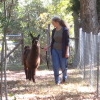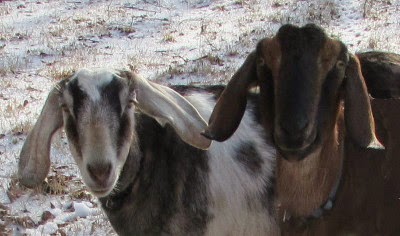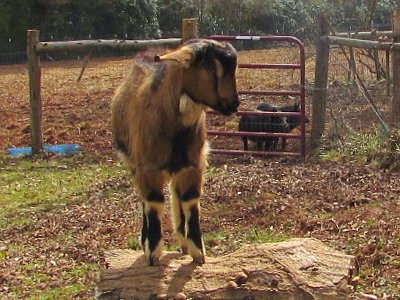| Online: | |
| Visits: | |
| Stories: |

| Story Views | |
| Now: | |
| Last Hour: | |
| Last 24 Hours: | |
| Total: | |
Earning Their Keep. When Are They? When Aren't They?
 |
| Lily and Surprise |
My goat plan for the year was to keep my two Nubians in milk until my Kinders kidded. Having been milkless in the past, I hope that by not breeding one or two of my does each year but milking them through, I'd benefit both the goats and us. They'll get a break from the stresses of pregnancy and kidding, and I'll have year around milk. I don't actually need a lot, especially if I'm not in a cheese making mode, but I want enough to keep my kefir alive and to help feed the pigs.
From what I've read, some goats are better suited than others for milking through. Every now and then I read about a doe who's still producing a quart or more per day after two years of kidding. That's more the exception than the rule, but that kind of producer is nice to have around.
It finally got to a point were Lily and Surprise together were giving a little more than a pint per day, but eating just as much as always. With my first due Kinder date coming up, it was time to make a decision. Each Nubian eats almost twice the amount that each Kinder eats. Even though I'm not one to usually rate things on a money scale (see “Contemplations on Value & Money“) the question of when they are no longer earning their keep, nonetheless, came to mind, especially since I'd already decided to sell them.
 |
| Helen and Daphne |
To some that may sound somewhat heartless, to get rid of animals when they no longer produce enough to make them “worth” it. That may make sense for a hobby homesteader, but for those of us working toward sustainability, it misses the point. The very definition of sustainability on a homestead requires balance. Any scenario where input exceeds output, or output exceeds supply, is not sustainable. Eventually, one thing gives up or the other runs out. Small scale sustainability requires tough decisions.
If I had the land and resources, I could happily allow all my animals to retire and live out their lives in comfort and ease. Having small acreage means we must carefully steward and protect our land from overuse. I would love to keep 20 goats, but must be realistic. I'm hoping I can manage 4 to 6 does over winter and 2 or 3 bucks. That includes pasture and forage plus areas for growing hay and feedstuffs. It also means I must sell or trade animals still in their prime so as to have value to the person taking them.
Long story short, Lily and Surprise have gone to a new home with someone who is thrilled to have them. I priced them in hopes they'd go together, i.e. $50 discount for buying both. I've learned that critters which are bought or sold with a companion have a much easier transition with less stress on everyone. They went to a 41 acre farm with other critters including other goats, plus animal-loving 4-H kids.
The only one who's not to happy about the whole thing is Bunny.
 |
| Bunny |
For some reason Surprise and Lily tolerated her, while the Kinders girls don't. But that's just life in the animal world and I know adjustments will eventually be made.
© March 2015 by Leigh at http://www.5acresandadream.com/
Source: http://www.5acresandadream.com/2015/03/earning-their-keep-when-are-they-when.html



